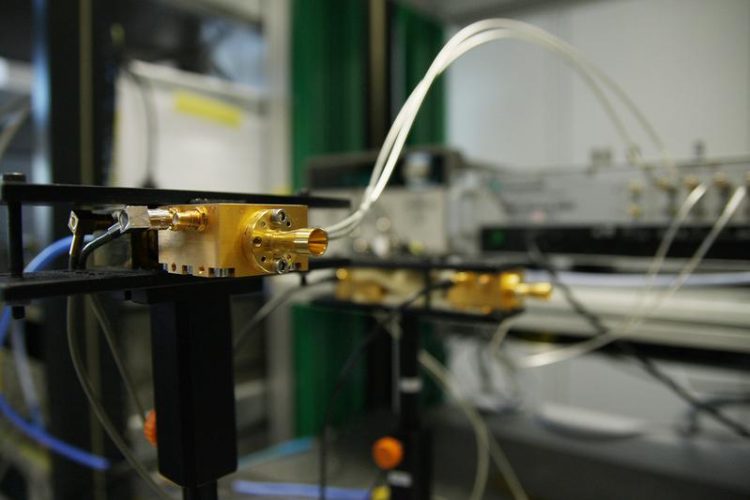Fraunhofer HHI and IAF demonstrate the first wireless real-time video transmission using Terahertz

© Fraunhofer HHI
Requirements placed on transmission capacities in communication networks are continuously growing, driven by new applications such as Industry 4.0, autonomous driving, AI-based cloud/edge computing, eHealth, Smart Cities and Virtual/Augmented Reality.
Today it is already evident that the next generation of mobile wireless technology (5G) and the underlying fiber optical network will not be able to cover requirements indefinitely. Bottlenecks will be unavoidable, especially in rural areas where the cost of installing fiber optical networks is significantly higher than in metropolitan areas.
Fraunhofer HHI, as one of the world's leading research institutes in the development of innovative telecommunication systems, is therefore conducting intensive research into Terahertz technology as a possible solution. These technologies are based on wireless transmission of data at high carrier frequencies and thus support transmission capacities of several 100 Gbit/s.
This means increasing transmission capacities by five to ten times the levels of existing wireless technologies. Terahertz transmission uses frequencies well above the 4G LTE/5G mobile wireless frequencies and is thus the ideal complement to existing technologies.
The Fraunhofer HHI researchers have been able to succeed in demonstrating real-time operation of Terahertz data transmission with a high data rate for the first time. A 4K video was transmitted in real-time between two computers via a wireless Terahertz link, achieving a data rate of 100 Gbit/s in real-time operations, even over longer periods of time.
Dr.-Ing. Robert Elschner, head of internal Terahertz research activities at the Fraunhofer HHI Photonic Networks and Systems department, explains: “We were able to achieve stable, continuous operation of the system for more than 70 hours. This is a significant milestone for wireless Terahertz technology.”
The components at the heart of the transmission system are fast, III-V semiconductor-based integrated circuits from Fraunhofer IAF, as well as a high-performance Terahertz modem from Fraunhofer HHI. The transmission used a carrier frequency of 300 GHz across a distance of 60 cm.
Dr. rer. nat. Colja Schubert, head of the responsible research group “Submarine and Core Systems” at Fraunhofer HHI, is confident that the rate and distance of transmission can be increased even further: “It should be possible to realize data rates of 400 Gbit/s and more over short distances. Using optimized antennas we'll be able to span distances of up to 1 km.”
Possible application scenarios for THz technology include high-bit-rate connections for users in rural areas, ad hoc networks, wireless extension of fiber optical networks, device-to-device communication and fixed/mobile wireless access in future mobile wireless networks.
Internal research projects and efforts in collaboration with international partners in the publicly funded EU project TERRANOVA (www.ict-terranova.eu) are driving research into THz technology at Fraunhofer to market-readiness.
Colja Schubert, colja.schubert@hhi.fraunhofer.de, +49 30 31002 252
https://newsletter.fraunhofer.de/-viewonline2/17386/365/535/ldL144xW/fudxaQFmH6/…
https://www.hhi.fraunhofer.de/en/press-media/press-releases.html
Media Contact
All latest news from the category: Physics and Astronomy
This area deals with the fundamental laws and building blocks of nature and how they interact, the properties and the behavior of matter, and research into space and time and their structures.
innovations-report provides in-depth reports and articles on subjects such as astrophysics, laser technologies, nuclear, quantum, particle and solid-state physics, nanotechnologies, planetary research and findings (Mars, Venus) and developments related to the Hubble Telescope.
Newest articles

Superradiant atoms could push the boundaries of how precisely time can be measured
Superradiant atoms can help us measure time more precisely than ever. In a new study, researchers from the University of Copenhagen present a new method for measuring the time interval,…

Ion thermoelectric conversion devices for near room temperature
The electrode sheet of the thermoelectric device consists of ionic hydrogel, which is sandwiched between the electrodes to form, and the Prussian blue on the electrode undergoes a redox reaction…

Zap Energy achieves 37-million-degree temperatures in a compact device
New publication reports record electron temperatures for a small-scale, sheared-flow-stabilized Z-pinch fusion device. In the nine decades since humans first produced fusion reactions, only a few fusion technologies have demonstrated…





















